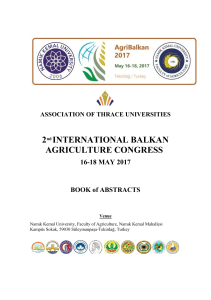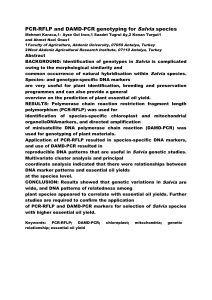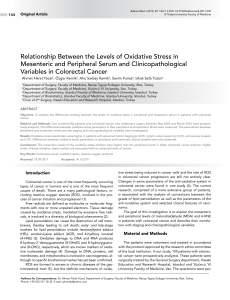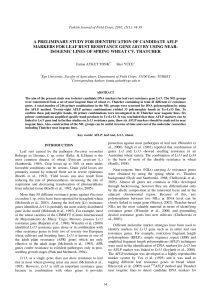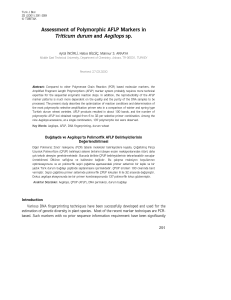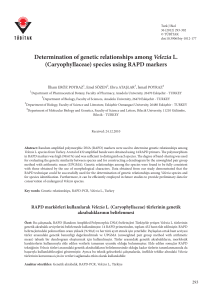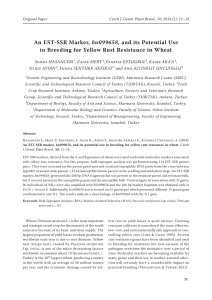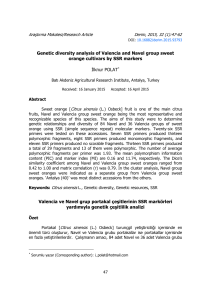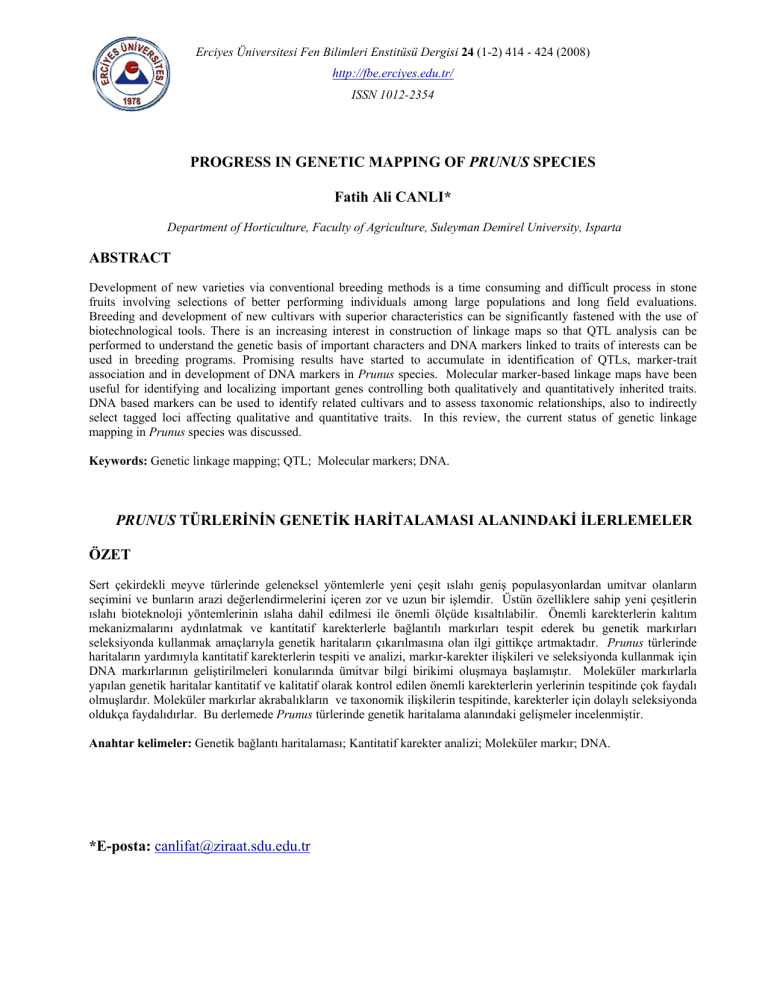
Erciyes Üniversitesi Fen Bilimleri Enstitüsü Dergisi 24 (1-2) 414 - 424 (2008)
http://fbe.erciyes.edu.tr/
ISSN 1012-2354
PROGRESS IN GENETIC MAPPING OF PRUNUS SPECIES
Fatih Ali CANLI*
Department of Horticulture, Faculty of Agriculture, Suleyman Demirel University, Isparta
ABSTRACT
Development of new varieties via conventional breeding methods is a time consuming and difficult process in stone
fruits involving selections of better performing individuals among large populations and long field evaluations.
Breeding and development of new cultivars with superior characteristics can be significantly fastened with the use of
biotechnological tools. There is an increasing interest in construction of linkage maps so that QTL analysis can be
performed to understand the genetic basis of important characters and DNA markers linked to traits of interests can be
used in breeding programs. Promising results have started to accumulate in identification of QTLs, marker-trait
association and in development of DNA markers in Prunus species. Molecular marker-based linkage maps have been
useful for identifying and localizing important genes controlling both qualitatively and quantitatively inherited traits.
DNA based markers can be used to identify related cultivars and to assess taxonomic relationships, also to indirectly
select tagged loci affecting qualitative and quantitative traits. In this review, the current status of genetic linkage
mapping in Prunus species was discussed.
Keywords: Genetic linkage mapping; QTL; Molecular markers; DNA.
PRUNUS TÜRLERİNİN GENETİK HARİTALAMASI ALANINDAKİ İLERLEMELER
ÖZET
Sert çekirdekli meyve türlerinde geleneksel yöntemlerle yeni çeşit ıslahı geniş populasyonlardan umitvar olanların
seçimini ve bunların arazi değerlendirmelerini içeren zor ve uzun bir işlemdir. Üstün özelliklere sahip yeni çeşitlerin
ıslahı bioteknoloji yöntemlerinin ıslaha dahil edilmesi ile önemli ölçüde kısaltılabilir. Önemli karekterlerin kalıtım
mekanizmalarını aydınlatmak ve kantitatif karekterlerle bağlantılı markırları tespit ederek bu genetik markırları
seleksiyonda kullanmak amaçlarıyla genetik haritaların çıkarılmasına olan ilgi gittikçe artmaktadır. Prunus türlerinde
haritaların yardımıyla kantitatif karekterlerin tespiti ve analizi, markır-karekter ilişkileri ve seleksiyonda kullanmak için
DNA markırlarının geliştirilmeleri konularında ümitvar bilgi birikimi oluşmaya başlamıştır. Moleküler markırlarla
yapılan genetik haritalar kantitatif ve kalitatif olarak kontrol edilen önemli karekterlerin yerlerinin tespitinde çok faydalı
olmuşlardır. Moleküler markırlar akrabalıkların ve taxonomik ilişkilerin tespitinde, karekterler için dolaylı seleksiyonda
oldukça faydalıdırlar. Bu derlemede Prunus türlerinde genetik haritalama alanındaki gelişmeler incelenmiştir.
Anahtar kelimeler: Genetik bağlantı haritalaması; Kantitatif karekter analizi; Moleküler markır; DNA.
*E-posta: [email protected]
F.A. Canlı / Erciyes Üniversitesi Fen Bilimleri Enstitüsü Dergisi 24 (1-2) 414 - 424 (2008)
415
1. INTRODUCTION
Genetic linkage mapping has become an indispensable part of breeding programs. Maps have been
constructed for most of the important crop plants. Construction of genetics maps is useful for; localizing
important traits by quantitative trait loci (QTL) analysis, understanding genetic basis of traits, comparative
mapping and evaluation studies. It also offers identification of markers linked to important traits and helps
cloning and characterization of important genes of interest.
The genetic complexity of quantitative traits; ranging from an infinite number of genes with tiny effects to
few genes with large effects has long been discussed. Current QTL mapping data suggests that few genes
account for most of the variation with a greater number of genes responsible for smaller amount of the
variance in many plant populations [1]. High density genetic maps allow breeders to analyze the genome of
an organism. QTL locations affecting any characteristics can be identified by the help of genetic maps [1].
Algorithms for QTL mapping in a wide range of experimental designs, including F2, backcross, recombinant
inbred and many other population designs were developed [2, 3]. These algorithms all have been used to test
correlation between marker genotypes and quantitative phenotypes [1].
With the increasing number of common loci identified in a series of Prunus species, the maps could be
combined and homologous areas and regions of translocations, insertions and deletions could be detected.
This would provide information on gene order conservation. Then studies of “synteny” in Prunus could
potentially be extended to other species in the Rosaceae [4].
Linkage maps generated in Prunus species can be compared using common markers that have been placed on
all Prunus linkage maps. Comparative mapping offers important benefits for genome analysis. DNA probes
can be used across-species in the same taxonomic family, increasing the number of genetic markers available.
If the linkage maps are co-linear, the location of common single gene or Quantitative Trait Loci (QTL) in one
species may predict results in other species [1]. For example, the use of the same SSR primers across species
depends on conservation of primer sites flanking SSRs between related taxa. Cross-species amplification of
SSR alleles with the same primers would increase value of these markers [5].
DNA markers are also essential tools in plant genetics with particular value in gene mapping and marker
assisted selection. Genetic markers linked with QTLs may enable indirect selection of complex traits.
416
Progress in Genetic Mapping of Prunus Species
Molecular markers have been successfully used to map individual genetic factors or QTLs controlling
complex traits [6, 7, 8]. The effectiveness of molecular markers in marker assisted selections (MAS) depends
on the linkage of the marker to the gene of interest. The closer the linkage between a marker and a gene, the
more efficient the selection is [4]. Therefore, efforts were put forward to the construction of separate linkage
maps to identify QTLs for each complex trait in many different populations of Prunus species.
2. MAPPING IN PRUNUS SPECIES
Although the stone fruits are economically important plant species, little was known about the genome
structure and its organization in this genus until the development and utilization of DNA markers. Among
stone fruits, peach is regarded as the best genetically characterized species and regarded as a model organism
in Prunus due to its short juvenile period, diploid genome (n=8) and small genome size: 5.9 x 108 bp or
0.61pg/diploid nucleus [9]. In other words, this is equal to about 290Mbp which is about double the size of
Arobidopsis thaliana genome [10]. Linkage mapping was first initiated with diploid species, especially with
peach, due to the relative simplicity compared to polyploids. Now, we will review the mapping efforts in
specific species of the Prunus genus.
2.1. Peach (P. persica L.)
The first genetic map in fruit trees was constructed by Chaparro et al. [11] in peach using an intraspecific F2
population. This map consisted of 83 RAPDs, one isozyme and four morphological characters. Dirlewanger
and Bodo [12] constructed a linkage map of peach with RAPD markers where eight linkage groups were
identified. Next year, two more genetic maps of peach were published; first one was from a interspecific
cross with almond and will be discussed in detail under the almond section [13], and the second one
constructed in an intraspecific cross based on 71 F2 individuals derived from ‘New Jersey Pillow’ and
KV77119 containing 47 markers (RFLP, RAPD and morphological markers) covering 332 cM [14]. Lu et al.
[15] constructed a linkage map of peach rootstocks with AFLP markers in 55 F2 individuals of the cross
Lovell x Nemared. They have scored 169 AFLP markers from 21 different primer combinations and assigned
153 markers to 15 linkage groups covering 1297 cM with the average interval of 9.1 cM. Another map of
peach from an intraspecific F2 population consisting of 249 markers including four agronomic characters
(peach/nectarine, flat/round fruit, acid/non-acid fruit, and pollen sterility) and one isoenzyme, 92 RAPD, 50
RFLP, eight inter-microsatellite amplification [IMA], and 115 AFLP markers was published in the same year
F.A. Canlı / Erciyes Üniversitesi Fen Bilimleri Enstitüsü Dergisi 24 (1-2) 414 - 424 (2008)
417
[16]. This map, will be useful in the detection of QTL’s for controlling acid and sugar content, consists of 11
linkage groups covering 712 cM with the average density of 4.5 cM. The mapping population was generated
from a flat non-acid peach, 'Fejalou Jalousia®' and an acid round nectarine 'Fantasia' [16]. These maps had
large distances between markers, and they are regarded as low density maps (4.5-8.5 cM/marker). They often
have excess linkage groups and unlinked orphan markers [10].
Shimada et al. [17] developed a genetic linkage map using 133 F2 plants from an intraspecific cross among
peach cultivars in Japan. The map of the rootstock cultivar, 'Akame', and the ornamental peach, 'Juseitou'
contained 83 markers consisting of 41 RAPD, 30 AFLP, and Inter-SSR, PCR-RFLP markers and also three
morphological trait loci; brachytic dwarf (dw), red leaf (Gr) and narrow leaf (nl). The map had ten linkage
groups ranging in length from 17 to 244 cM and covered more than 960 cM.
The morphological
characteristic, nl co-segregated with the dw locus. DNA markers found to be linked to Gr and dw loci could
be utilized in peach breeding. Dettori et al. [18] constructed a linkage map of a BC1 progeny (Prunus persica
x (P. persica x P. ferganensis)) consisting of 109 loci (74 RFLPs, 17 SSRs, 16 RAPDs, and two
morphological traits) covering 521 cM on 10 linkage groups with an average distance between markers of 4.8
cM. JOINMAP 2.0 software was used to integrate loci segregating in five different ratios. Two monogenic
traits, flesh adhesion (F/f) and leaf glands (E/e) were placed on the map. Homologies were found among the
respective linkage groups. No relevant differences were observed in the linear order of the common loci [18].
Joobeur et al. [19] constructed the first saturated linkage map for Prunus using an almond x peach F2
progeny with 246 markers (11 isozymes and 235 RFLPs) covering distance of 491 cM with the average map
density of 2.0 cM/marker. The map had only four gaps of 10 cM. This map, named as the T x E map, is now
accepted as a reference map for Prunus species and improved by the addition of SSRs, RFLPs and STSs [20,
21]. Its progressive improvement continued by the addition of 264 more SSRs [22]. Now among the 817
markers on the TxE map, 756 of them were derived from available DNA sequences and 198 of these are
known to correspondence to proteins [10]
Dirlewanger et al. [8] mapped QTLs controlling fruit quality in peach using a F2 population. The QTLs for
almost all qualitative components were on two linkage groups and the fraction of the total variation in each
trait explained by the QTL was very high and accounted for up to 90 % of the variation of some characters.
All the detected QTLs displayed the same effect as the parental phenotypes for productivity, fresh weight,
418
Progress in Genetic Mapping of Prunus Species
pH, quinic acid, sucrose and sorbitol content. On the contrary, some QTL for maturity date, titratable acidity,
malic and citric acids and fructose, showed the same effect as parental phenotypes, but others displayed the
opposite effect.
2.2. Almond (P. dulcis L.)
Viruel et al. [23] constructed the first map for almond using RFLP’s in a cross between two almond varieties;
Ferragnes and Tuano. Eight linkage groups were constructed with the 93 heterozygous loci in ‘Ferragnes’
and eight linkage groups were constructed with 69 heterozygous loci in ‘Tuano’. The map span was about
400 cM. Another linkage map from a cross between a dwarf peach selection (54P455) and an almond
cultivar ‘Padre’ was constructed covering 800 cM with 107 markers [13]. Markers were assigned to nine
different linkage groups covering 800 cM [11 markers remained unlinked].
A saturated map for almond was published by Joobeur et al. [19] using a F2 progeny derived from a cross
between almond (cv. Texas) and peach (cv. Earlygold) as described under the peach mapping section. This
map (TxE) is considered as a reference map for Prunus species and has progressively improved. With the
addition of new RFLPs and SSRs, this map was improved by Aranzana et al. [20]. The current high density
version of T x E map [24] covers 519 cM with 562 markers (361 RFLPs, 185 SSRs, 11 isozymes and 5
STSs). This map has an average density of 0.92 cM/marker and the largest gap in the map is 7 cM.
A second-generation linkage map for almond was constructed with the markers of simpler methods, such as
RAPDs and SSRs [25]. Fifty-four RAPD markers and SSRs were added to the molecular map previously
constructed with 120 RFLPs and seven isozyme genes. Polymorphism was detected in six of the eight Prunus
SSRs studied, which lead these to be mapped. All markers placed on the 8 linkage groups, which were
previously identified, resulting in a 5% increase to the previous map. Another map (P x 5 (Almond cv. Padre
x Peach cv. 54P455)) was published by Bliss et al. [26] using 161 of such simpler markers.
After TxE map, two more low density maps, covering the whole genome at distances of 10 to 25 cM, were
published using markers from the TxE map. The first one helped locating the map position of genes for selfincompability [27] shell hardness [28] and bloom time [7]. The second one published by Jauregui et al. [29]
used an interspecific F2 population between almond and peach with selected markers of eight linkage groups
from previously developed Prunus maps. Contrary to expected eight linkage groups in Prunus, markers were
F.A. Canlı / Erciyes Üniversitesi Fen Bilimleri Enstitüsü Dergisi 24 (1-2) 414 - 424 (2008)
419
mapped to seven linkage groups and markers of groups 6 and 8 in previous maps formed a single group. By
studying pollen fertility and chromosome behavior of meiosis in the F1 generation, the presence of a
reciprocal translocation between ‘Garfi’ almond and ‘Nemared’ peach was suggested [29]. This map located
some of the genes for nematode resistance and flower color.
2.3. Cherries (P. avium L. and P. cerasus L.)
There have been several partial genetic maps published for the subgenus Cerasus. The first map published in
Cerasus is a sweet cherry (P. avium L.) map constructed with 89 RAPDs and two allozymes using a
population of 56 microspore-derived callus culture plants of cv. Emperor Francis. The map had 10 linkage
groups covering 503 cM. Another map, which had seven linkage groups, was constructed [30] using isozyme
markers only.
A RFLP genetic linkage map of two tetraploid sour cherry (P. cerasus L.) cultivars, ‘Rheinische
Schattenmorelle’ (RS) and ‘Erdi Botermo’ (EB), was developed [31]. The RS linkage map consists of 19
linkage groups covering 461.6 cM and EB linkage map consists of 16 linkage groups covering 279.2 cM.
Fifty-three markers mapped in both parents allowed for the identification of 13 sets of homologous linkage
groups. Homoeologous relations could not be determined since only 15 of the probes detected duplicate loci.
Fifty-nine of the markers on the linkage maps were identified with probes, which had been used in other
Prunus linkage maps.
A second generation linkage map of two tetraploid sour cherry cultivars (Prunus cerasus L., 2n=4x=32), RS
and EB, was constructed by addition of new SSR markers to a previously constructed map. Forty-five SSR
primer pairs from apple, peach, sour cherry and sweet cherry were screened and 10 informative SSRs
yielding 16 markers were added to the sour cherry linkage map having 19 linkage groups covering 442 cM
[32].
The expanded Prunus genetic linkage map constructed from peach and almond covers 1,144 cM [26]. Sour
cherry linkage map, being tetraploid, should be two times the length of the peach map. However the
published map covers only one fourth of the expected length due the difficulty of having informative markers
in tetraploids compared to diploids [31].
420
Progress in Genetic Mapping of Prunus Species
QTL analysis of flower and fruit traits in sour cherry using the RFLP map of EB and RS was conducted [33].
The location and effects of QTL for eight traits and eleven putatively significant QTLs (LOD > 2.4) were
detected for six characters (bloom time, ripening date, % pistil death, % pollen germination, fruit weight, and
soluble solid concentration). The percentage of phenotypic variation explained by a single QTL varied from
12.9 % to 25.9 %. The QTLs for flower traits [bloom time, % pistil death and % pollen germination] were
mapped to the same linkage group, EB 1.
2.4. Apricot (P. armeniaca L.)
There have been several genetic linkage maps published for apricot in recent years. In the first one, Hurtado
et al. [6] placed 132 markers (33 RAPDs, 82AFLPS, 4 RFPLs and 13 SSRs) on cv. Goldrich map consisting
of eight linkage groups covering 511 cM with a 3.9 cM average distance between adjacent markers. The
second map developed by Vilanova et al. [34] covers 602 cM in 11 linkage groups. The average distance
between adjacent markers is 3.84 cM. The last map for apricot was constructed using RFLP and SSR
markers [35], which had been previously mapped in almond x peach map constructed by Joobeur et al. [19]
and Aranzana et al. [20], from a cross between cv. Polonais and Stark Early Orange. Stark Early Orange map
is 669 cM having 141 markers and the Polonais map is 538 cM in length with 110 markers.
2.5. Plums (P. domestica L., P. salicina LindI. and P. cerasifera Ehrh.)
The first linkage map of Myrobalan plum (P. cerasifera Ehrh.) P.2175 and a saturated map of the almondpeach GN22 were constructed using a F1 progeny of 101 hybrids obtained from a three-way cross between
the Myrobalan plum P.2175 and the almond–peach hybrid GN22. This three-way interspecific Prunus
progeny was used to associate root-knot nematode (RKN) resistances from peach and Myrobalan with the
other favorable traits for Prunus rootstocks [21]. To construct one genetic map for each parent using `double
pseudo-testcross' analysis model, two hundred and seventy seven SSRs derived from different Prunus specis
were tested for polymorphism. The P.2175 Myrobalan map consisted of the Ma gene and 93 markers
covering 524.8 cM. 166 markers (one SCAR, 165 SSRs), R
MiaNem
gene and the Gr gene were mapped to
seven linkage groups confirming the translocation in previous maps. Markers of groups 6 and 8 of the
previous maps placed in a single group in the GN22 map [21].
F.A. Canlı / Erciyes Üniversitesi Fen Bilimleri Enstitüsü Dergisi 24 (1-2) 414 - 424 (2008)
421
3. THE DIFFICULTY OF MAPPING IN POLYPLOIDS
Although linkage maps of polyploid Prunus species could provide broad potential advantages, linkage map
construction in these species, such as in sour cherry, are lagging compared to other Prunus species due to
their polyploid origins. Construction of linkage maps in polyploids is difficult. There are large numbers of
genotypes for each primer pair expected in a segregating population and these genotypes cannot always be
identified by their banding patterns.
Secondly, the genome constitution [allopolyploidy versus
autopolyploidy] in many polyploids is not clearly understood [36]. To overcome the difficulty of mapping in
polyploids, Wu et al. [36] proposed the use of Single Dose Restriction Fragments [SDRF]. In the sour cherry
mapping population, informative markers will be those that are Single Dose Restriction Fragments [SDRFs]
in one or both parents (i.e., [+--- x ----], [---- x +---], or [+--- x +---], segregating 1:1, 1:1, or 3:1 respectively)
[36, 37, 38]. To identify SDRFs with a confidence level of 98 % in the four ploidy levels, a population
size of at least 75 is needed [36].
Software programs have been developed to aid with the mapping. JOINMAP was developed by Piet Stam at
the center for Plant Breeding and Reproduction Research, Wagenigen, The Nederlands [39].
Like
MAPMAKER [40], JOINMAP can construct maps of single crosses, but it also has advantages of merging
maps obtained from distinct experiments and published recombination frequencies that are important in
comparative mapping. Unlike MAPMAKER, JOINMAP can also be used with markers segregating in
various ratios (3:1, 1:1) within the same cross [4].
4. CONCLUSION
The TxE map has been accepted as a reference map for Prunus species since it has many transferable markers
(SSRs, RFLPs and isozymes) that have been used to construct maps for other Prunus species. Some of the
linkage maps in Prunus species (cherry [41], almond [19] and apricot [35]) were compared with TxE map
using common markers. Comparative mapping results offered important benefits for genome analysis, for
example; comparative mapping results with other species utilizing these markers clearly showed that the
order and distributions of these markers in the eight linkage groups are generally co-linear and conserved
across the different Prunus species. In addition, results in Prunus showed that SSRs are frequently conserved
among cherry, peach and almond [32]. With the increasing number of common loci identified in a series of
Prunus species, the maps could be combined. This would provide information on gene order conservation.
422
Progress in Genetic Mapping of Prunus Species
Then studies of “synteny” in Prunus could potentially be extended to other species in the Rosaceae [4]. A
good example of this has already been observed that a reciprocal translocation occurred between linkage
groups of 6 and 8 in an F2 progeny of ‘Garfi’ almond and ‘Nemared’ peach [29].
The marker densities of Prunus maps, especially peach and almond maps, are saturated and dense enough to
use MAS for most simple characters. Although the information is available, MAS for commercial breeding
applications is still in its infancy [10]. The best example for the molecular marker linked traits in Prunus is
self-incompability with potential promising application in MAS in Japanese apricot, sweet cherry, sour cherry
and almond. MAS is also being employed in rootstock breeding programmes to incorporate root-knot
nematode resistance genes from Nemared [15, 42, 43] and another resistance gene coming from Myrobalan
[44].
Other promising candidate markers linked to agronomically important QTLs in Prunus species are
emerging; such as markers for PPV resistance in apricot [45] and markers for late blooming in almond [7]
expected to be integrated in breeding programs in near future.
On the other hand, the use of molecular markers for selections of the other well-characterized genes
controlling characters such as ripening time, fruit sweetness, fruit quality, fruit shape or flesh color have not
been published [10], because these characters are quantitatively inherited. Although QTL analysis were
performed for some fruit characters in several Prunus species such as sour cherry [33] and peach [8, 46],
more comprehensive information on the map positions, numbers and especially on the effects of particular
QTLs of interests is required to integrate these QTLs linked markers into commercial breeding programs.
Other efforts to establish marker trait associations such as; bulked segregant analysis to associate makers to
bloom time [47] and other agronomically important QTLs of interests in addition to mapping studies are
required to speed up the integration of MAS strategies in Prunus breeding programs.
The information obtained in a Prunus species on genes and their locations allows us to use this information
and predict the results in other Prunus species. Because the linkage maps are co-linear in Prunus species, the
location of a common single gene or QTL in one species may predict results in other species [1]. A good
example of this is that the mapping results using SSRs markers clearly indicated that SSRs developed in one
Prunus species have good utility in other, and are transportable among Prunus species [48]. Having crossspecies amplification, SSRs are highly useful for comparative mapping analysis and identification of
homoeologous linkage groups. With the availability of more of these transportable markers and increased
F.A. Canlı / Erciyes Üniversitesi Fen Bilimleri Enstitüsü Dergisi 24 (1-2) 414 - 424 (2008)
423
number of common loci mapped in Prunus species, it should be possible to identify homologous areas, and
regions of translocations, insertions or deletions. Such data would also provide information on gene order
conservation in Prunus and in the Rosaceae family.
REFERENCES
1.
A. H. Paterson, Genome Res., 5 (1995) 321.
2.
S. J. Knapp, in Proceeding of The Second Symposium of The American Society for Horticultural
Science and Crop Science Society of America, Analysis of Molecular Marker Data , Corvallis, Ore.
Amer. Soc. Hort. Sci., Alexandria, VA, (19949 1.
3.
E. A. Carbonell, et al., Biometrics., 48 (1992) 305.
4.
W. V. Baird, et al., Hortsci., 31 (1996) 1099.
5.
W. Powell, et al., Trends in Plant Sci., (1996) 1.
6.
M. A. Hurtado, et al., Theor. Appl. Genet., 105 (2002) 182.
7.
J. Ballester, et al., Plant Breed., 120 (2001) 268.
8.
E. Dirlewanger, et al., Theor. Appl. Genet., 98 (1999) 18.
9.
W. V. Baird, et al., J. Am. Soc. Hor.t Sci., 199 (1994) 1312.
10. A. G. Abbott, et al., Peach in Genome Mapping and Molecular Breeding in Plants, Fruits and Nuts
7 (2007) 137.
11. J. S. Chaparro, et al., Theor. Appl. Genet., 87 (1994) 805.
12. E. Dirlewanger, C. Bodo, Euphytica., 77 (1994) 101.
13. M. R. Foolad, et al., Theor. Appl. Genet., 91 (1995) 262.
14. S. Rajapakse, et al., Theor. Appl. Genet., 90 (1995) 503.
15. Z. X. Lu, et al., Genome., 41 (1998) 199.
16. E. Dirlewanger, et al., Theor. Appl. Genet., 97 (1998) 888.
17. T. Shimada, et al., Jpn. Soc. Hortic. Sci., 69 (2000) 536542.
18. M. T. Dettori, et al., Genome., 44 (2001) 783.
19. T. Joobeur, et al., Theor. Appl. Genet., 97 (1998) 1034.
20. M. J. Aranzana, et al., Theor. Appl. Genet., 106 (2003) 819.
21. E. Dirlewanger, et al., Theor. Appl. Genet., 109 (2004) 827.
22. W. Howad, et al., Genetics., 171 (2005) 1305.
23. M. A. Viruel, et al., Theor. Appl. Genet., 91 (1995) 964.
424
Progress in Genetic Mapping of Prunus Species
24. E. Dirlewanger, et al., Procnatl. Acad. Sci., USA, 101 (2004) 9891.
25. T. Joobeur, et al., Genome., 43 (2000) 649.
26. F. A. Bliss, et al., Genome., 45 (2002) .
27. J. 27-Ballester, et al., Plant Breed., 117 (1998) 69.
28. P. Arús, et al., Acta Hort 484 (1999) 331.
29. B. Jauregui, et al., Theor. Appl. Genet., 102 (2001) 1169.
30. R. Boskovic, K. R. Tobutt, Euphytica., 103 (1998) 273.
31. D. Wang, et al., Theor. Appl. Genet., 97 (1998) 1217.
32. F. A. Canli, P. J. Biol. Sci., 7 (2004) 1676.
33. D. Wang, et al., Theor. Appl. Genet., 100 (2000) 535.
34. S. Vilanova, et al., Theor. Appl. Genet., 107 (2003) 239.
35. P. Lambert, et al., Theor. Appl. Genet., 122 (2004) 3.
36. K. K. Wu, et al., Theor. Appl. Genet., 83 (1992) 294.
37. M. Hemmat, et al., Molecular Marker Linkage Map of Apple, J. Hered., 85 (1994) 4.
38. M. E. Sorrells, Crop Sci., 32 (1992) 1086.
39. P. Stam, JOINMAP. Plant J., 3 (1993) 739.
40. S. M. Lincoln, et al., Constructing Genetic Maps with MAPMAKER EXP 3.0. 3rd ed. Whitehead inst.
Tech. Rpt., Cambridge, Mass., (1992).
41. E. Dirlewanger, et al., Acta Hort., 622 (2003) 177.
42. T. Yamamoto, T. Hayashi, Sci Hort., 96 (2002) 81.
43. P. Arús, et al., Acta Hort., 658 (2004) 567.
44. M. Claverie, et al., Theor. Appl. Genet., 109 (2004) 1318.
45. O. Sicard, et al., Tree Genetics and Genomes., 4 (2008) 359.
46. C. Etienne, et al., Theor. Appl. Genet., 105 (2002) 145.
47. F. A. Canli, P. J. Biol. Sci., 7 (2004) 1684.
48. F. A. Canli, PhD Thesis, Michigan State University, Lansing, MI, USA, (2002).

